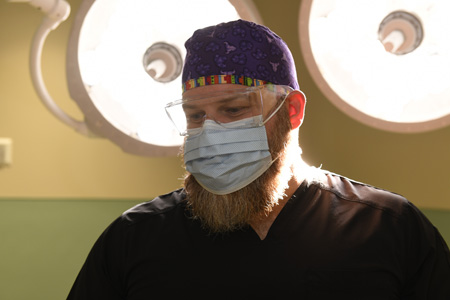Ankle Arthroscopy
![]() Ankle arthroscopy can be useful in treating a variety of disorders of the ankle joint, which may be caused by trauma or by degenerative, inflammatory, or neoplastic conditions. It is used to diagnose and treat many joint problems, including:
Ankle arthroscopy can be useful in treating a variety of disorders of the ankle joint, which may be caused by trauma or by degenerative, inflammatory, or neoplastic conditions. It is used to diagnose and treat many joint problems, including:
- Repairing ligament injuries
- Removing scar tissue
- Removing damaged cartilage
- Removing bone fragments
- Evaluating the extent of arthritis
Also known as keyhole surgery or minimally invasive ankle surgery, ankle arthroscopy involves using very small incisions to gain access to the ankle joint. Fluid is injected into the joint, which expands the joint and allows your foot and ankle surgeon a clear view and room to work. The inside of the ankle joint can be inspected using an arthroscope, which has a fiber optic light and a small video camera. With the video image as a guide, your surgeon can diagnose the problem and address treatment options.
Not all ankle surgeries can be done or are good candidates for arthroscopy. The list of conditions below is comprehensive for those disorders in which the technique is useful. The alternative is open ankle surgery, which results in larger scars and generally more post-operative pain. Your Celebration Orthopaedics foot and ankle surgeon will discuss which option is best for your treatment needs.
 The various disorders in which the technique is useful include:
The various disorders in which the technique is useful include:
- Ankle arthritis
- Footballers' ankle (Anterior Ankle Impingement)
- Unstable ankle
- Lateral ligament reconstruction
- Ankle pain following fracture
- Loose bodies within the ankle
- Osteochondral defects of the talus
- Diseases of the synovium
- Undiagnosed ankle pain
Why Ankle Arthroscopy?
The very small incisions used result in minimal soft tissue disruption and trauma, resulting in:
- Significantly lower pain levels than an open approach
- The ankle is comfortable to weight bear through on the day of surgery
- Most cases can be performed on a day-case basis
- Lower infection rates than opting for the open surgical approach
- Earlier return to work/function/sports
- Little scarring
- Minimal effect if further surgery to the ankle is required
